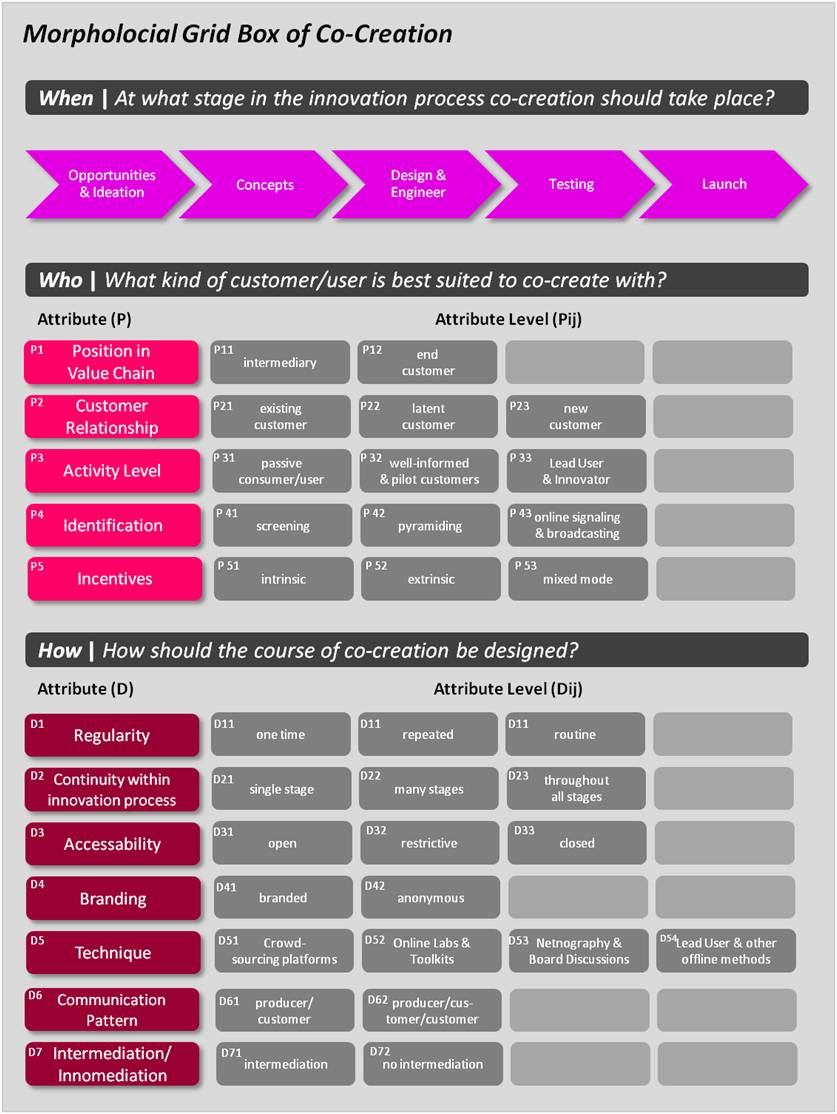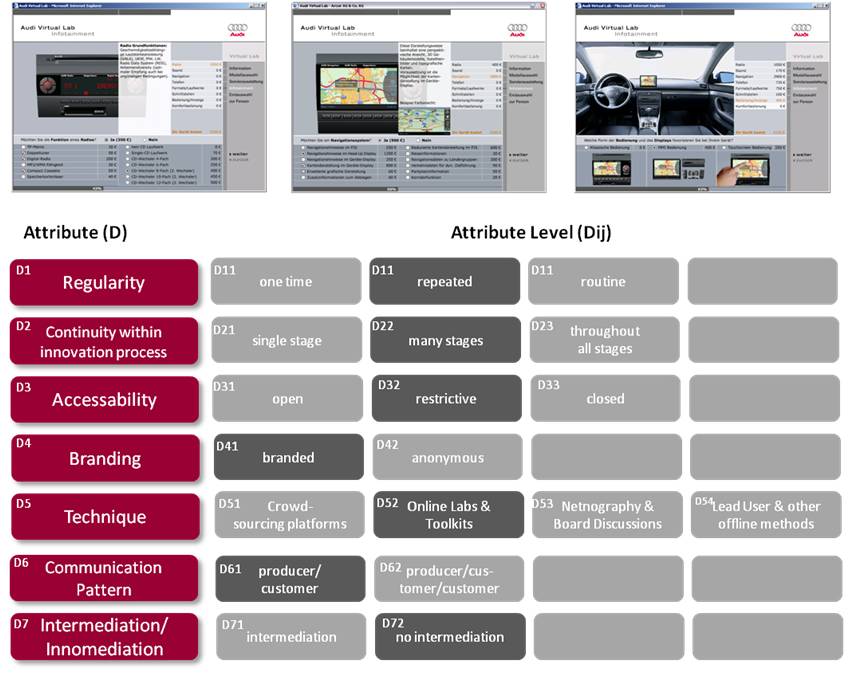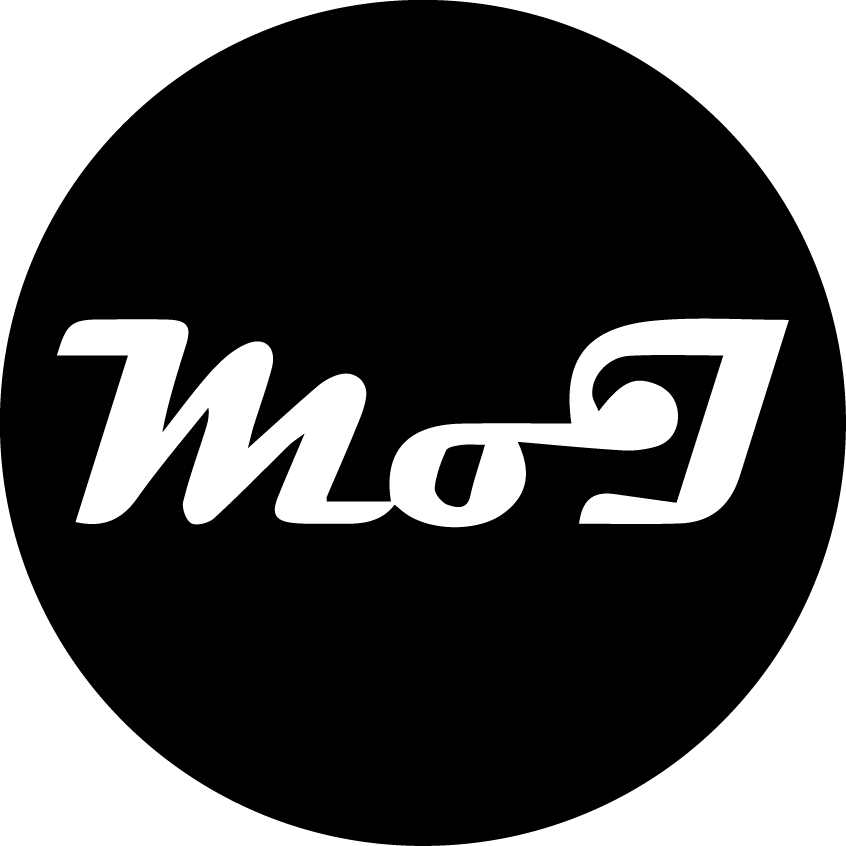1. Introduction
With the morphology of co-creation I want to offer an analysis framework which helps to systematically align co-creation and open innovation activities along its major constitutional dimensions. In order to become familiar with the design of co-creation the following key questions are considered in a morphological grid box:
When – At what stage in the innovation process co-creation should take place?
Who – What kind of customer/user is best suited to co-create with?
How – How the course of co-creation should be designed?
2. The morphological grid box of co-creation
On the one hand side the morphological grid box illustrated in figure 1 aims to help practitioners and academics alike to encourage creative thinking. But then again this conceptual framework allows to tackle co-creation and open innovation projects in a more systematic way. The co-creation attributes included in the grid box make no claim to be complete however impressively show the huge variety of options to design co-creation between firms and users. By combining the parameter values of the different co-creation attributes 168 theoretical alternatives to identify and motivate different types of users (Attribute Pij) can be generated. Moreover 864 options exist to design co-creation activities (Attribute Dij) in an idealized innovation process consisting of five stages. The morphological analysis helps to check feasibility and specify your co-creation activities and projects by cross consistency assessment and elimination of illogical solution combinations in the grid box.

Figure 1: The morphological grid box of co-creation
3. WHEN | At what stage in the innovation process co-creation should take place?
One of the core questions of co-creation is at what stage in the innovation process the involvement of users should take place. An idealized innovation process represents how products move from (1) opportunities & ideas, to (2) concepts, to (3) design & engineering, to (4) testing, and to (5) launch. The question regarding the WHEN is directly linked to the actual purpose of the co-creation task like e.g. generate ideas, evaluate and refine concepts, specify product features or create prototypes. Whereas the integration of customers in the latter stages such as test and launch is common practice especially in market research more and more modern techniques of co-creation and open innovation focus on the fuzzy front end of innovation and the design & development itself. E.g. Netnography allows identifying new opportunities to innovate, Crowdsourcing platforms allow to un-leash the creativity of the masses and online toolkits such as user design enable thousands of users to create their preferred future products using virtual prototypes. The single co-creation methods are described more detailed in the article “Methods and Tools for Co-Creation and Open Innovation” (Bartl 2009).
4. WHO | What kind of customer/user is best suited to co-create with?
The position within the value chain allows us to think of different types of possible partners for co-creation. The co-creation literature definitely focuses mainly on the involvement of end customers, consumers or users. However given some circumstances it makes also sense to integrate other intermediary groups such as corporate clients, reseller, distribution partners, trade partners, governmental institutions or consumer associations. The duration and stability of the customer relationship leads to a differentiation between existing, latent and new customers. An advanced activity level can be assigned to particular types of customers such as lead users, early adopters of pilot customers. This makes them co-innovators and partners in NPD rather than passive consumers or simple buyers of products. After having identified an ideal mix of characteristics for a co-creation candidate to solve a certain innovation task the core questions arise of how to identify and motivate the users to co-create. From lead user literature we know that screening and pyramiding are valuable approaches to identify advanced users. Recent research studies show that online-signaling or broadcasting can be an effective instrument to identify innovative users in consumer products markets. This is based on the self-selection effect which might occur because sophisticated and well-performing consumers with higher involvement in the product of interest decide to participate in the co-creation task. Engaging in co-creation activities can be considered as a function of intrinsic and extrinsic motivation. Consumers are intrinsically motivated if they value an activity for its own sake. They are extrinsically motivated if they focus on outcomes that are separable from the activity per se. Drawing on a rich body of motivation research relevant motives are “curiosity”, self efficacy”, “skill development”, “information seeking”, “intrinsic playful task”, “recognition”, “altruism and community support”, “make friends”, “personal need/ dissatisfaction” or “compensation and monetary rewards”. Research as well as the experiences made in numerous real business projects show that the intrinsic motivational dimension should be the focus to engage high involved, interested and creative co-creation partners. Nevertheless when more and more companies aim to co-create with users a sustained future motivational mix will consequentially include a balance of intrinsic and extrinsic incentives such as licensing models or other monetary compensations for successful user innovations.
5. HOW | How should the course of co-creation be designed?
Summarized in figure 2 I want to give an example of how the grid box can be used to discuss the design of a real business co-creation project. The article “Co-Creation in the Automobile Industry – The Audi Virtual Lab” (Bartl 2009) describes how more than 7.000 customers in Japan, USA and Germany participated in the co-development of the Audi in-car multimedia system.

Figure 2: Co-Creation Design of the Audi Virtual Lab
Given that two consecutive projects termed the “Audi Virtual Lab 1” and the “Audi Virtual Lab 2” were conducted we can classify the Virtual Lab as repeated co-creation within the dimension “Regularity”. The first project can be assigned to the “Concept” stage whereas the second project was positioned in the “Design & Engineer” stage of NPD. Hence the co-creation took place in two stages. An interaction e.g. with an electronics developers community would allow a continuous co-creation throughout all stages however was not applied in the Audi case. The access to the Audi branded Virtual Labs were barely open as a pop up banner for recruiting participants on the Audi homepage appeared randomly for every n-th visitor. No further mechanisms for innomediation (Sawhney/Prandelli/Verona 2003) such as panel providers, community operators or marketplace operators were involved. As co-creation techniques a web-based user design to individually configure a virtual prototype of the infotainment device was applied. The users did not have the possibility to interact and communicate with each other like they would have using other co-creation designs such as crowdsourcing platforms or forum discussions. In summary by using the nomenclature introduced in figure 1 the Audi Virtual Lab co-creation design is described with the typology D11, D22, D32, D41, D52.
6. Conclusion
Applying the morphological framework over years now I wanted to share this simple but very helpful instrument. It turned out to be a useful tool in various ways, e.g.
• for the assessment and benchmark of current co-creation and open innovation activities.
• as a practical guide to actually design the co-creation interaction and the experiment design of online toolkits.
• as a planning tool to align future projects and an overall open innovation/co-creation program.
• to define problem statements and questions in academic research.
Would you like to download this article?
References
Bartl, Michael (2006). Virtuelle Kundenintegration in die Neuproduktentwicklung. DUV Publishing, Wiesbaden.
Bartl, Michael (2009). Co-Creation in the Automobile Industry – The Audi Virtual Lab. MICHAELBARTL.COM, Munich.
Bartl, Michael (2009). Methods and Tools for Co-Creation and Open Innovation. MICHAELBARTL.COM, Munich.
Rüdiger, Mathias (2001). E-Customer-Innogration, Working Paper WHU, Otto Beisheim School of Management.
Sawhney, Mohanbir; Prandelli Emanuela; Verona, Gianmario (2003). The Power of Innomediation. MIT Sloan Management Review, January 15, 2003.

